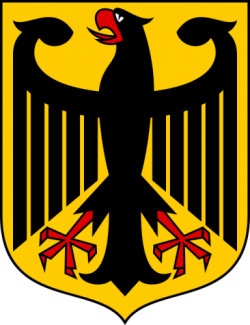Coat of arms of Germany

The coat of arms of Germany displays a black eagle (the Bundesadler "Federal Eagle", formerly Reichsadler "Imperial Eagle") on a yellow shield (Or, an eagle displayed sable). It is a re-introduction of the coat of arms of the Weimar Republic (in use 1919–1935) adopted by the Federal Republic of Germany in 1950. The current official design is due to Tobias Schwab (1887–1967) and was introduced in 1928.
The German Empire of 1871-1918 had re-introduced the medieval coat of arms of the Holy Roman Emperors, in use during the 13th and 14th centuries (a black single-headed eagle on a golden background), before the emperors adopted the double-headed eagle, beginning with Sigismund of Luxemburg in 1433. The single-headed Prussian Eagle (on a white background, Argent, an eagle displayed sable) was used as an escutcheon to represent the Prussian Kings as dynasts of the German Empire. The Weimar Republic introduced a version in which the escutcheon and other monarchical symbols were removed.
© Symbols.com
